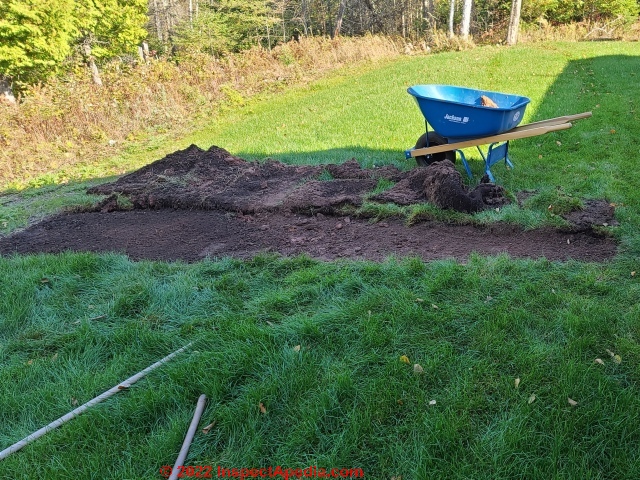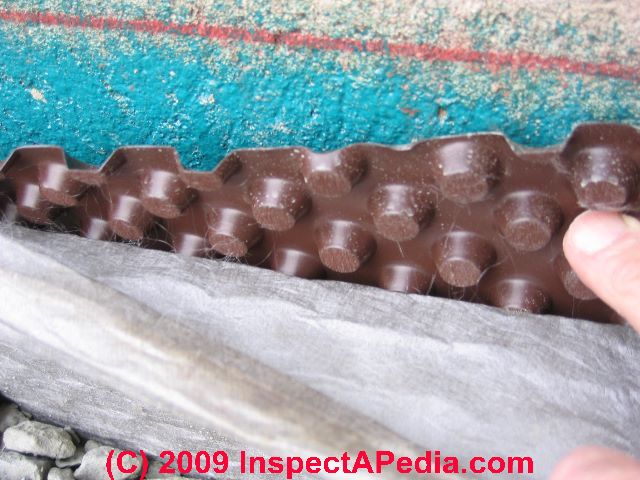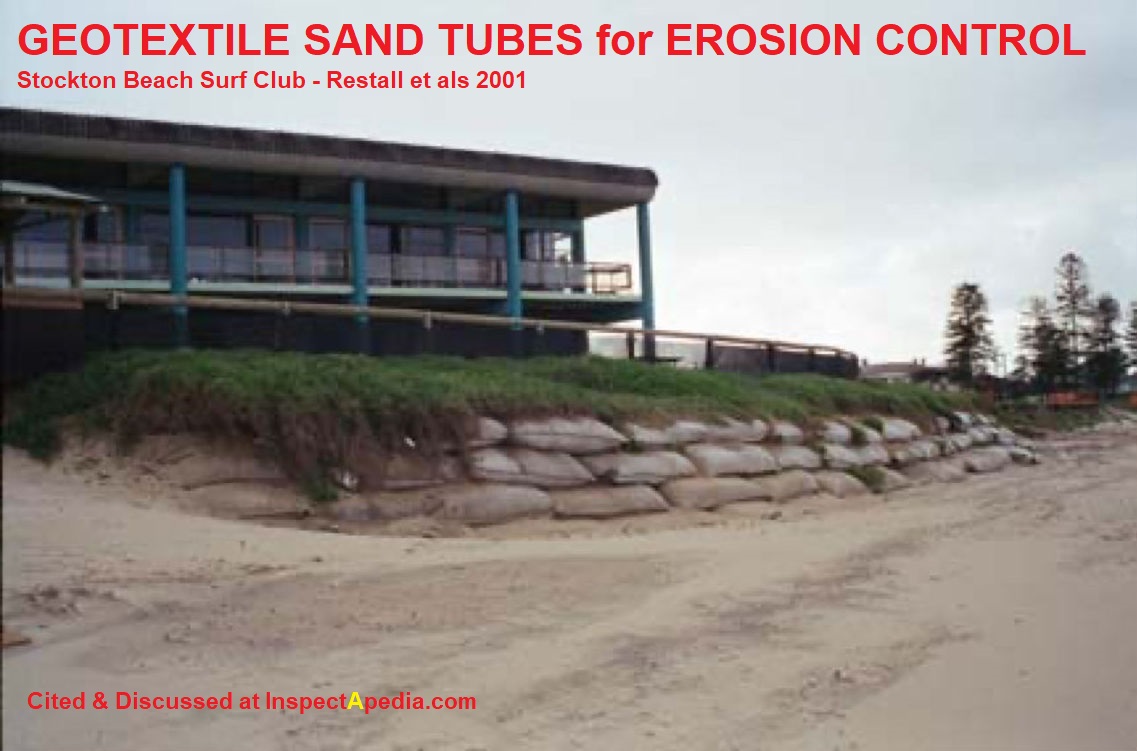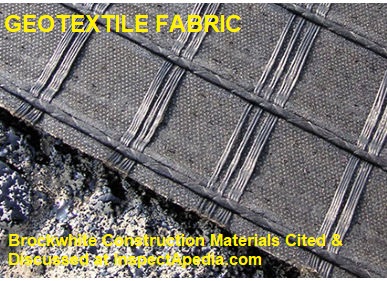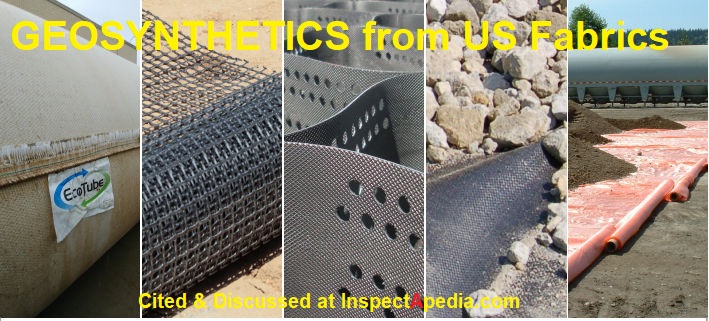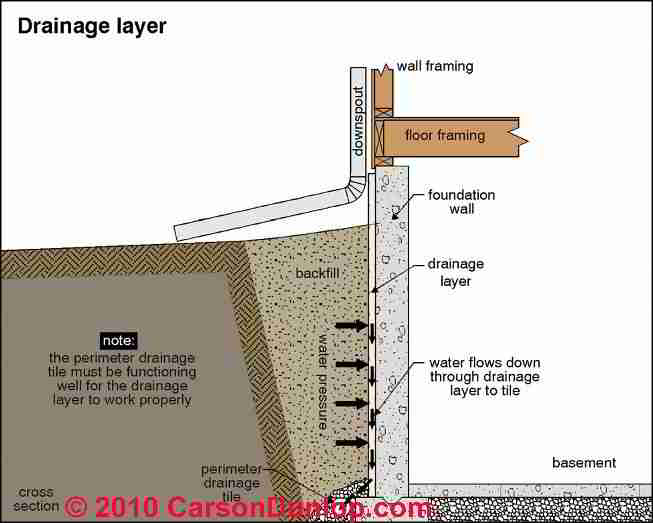 Geotextiles: types, uses, sources
Geotextiles: types, uses, sources
for building & site erosion, septics, drainage control
- POST a QUESTION or COMMENT about geotextiles, matting, netting
This article describes geotextiles, woven and non-woven synthetic fabrics, used for a wide variety of purposes in and on buildings and at building sites to control water drainage, erosion, or to construct septic systems, drives, walks, or for other purposes.
Page top illustration: a geotextile placed against the foundation wall combined with other materials can help assure that water near the foundation is conducted to footing drains and away from the building.
Sketch courtesy of Carson Dunlop Associates, a Toronto home inspection & education company.
InspectAPedia tolerates no conflicts of interest. We have no relationship with advertisers, products, or services discussed at this website.
- Daniel Friedman, Publisher/Editor/Author - See WHO ARE WE?
Types of Geotextiles & Their Uses
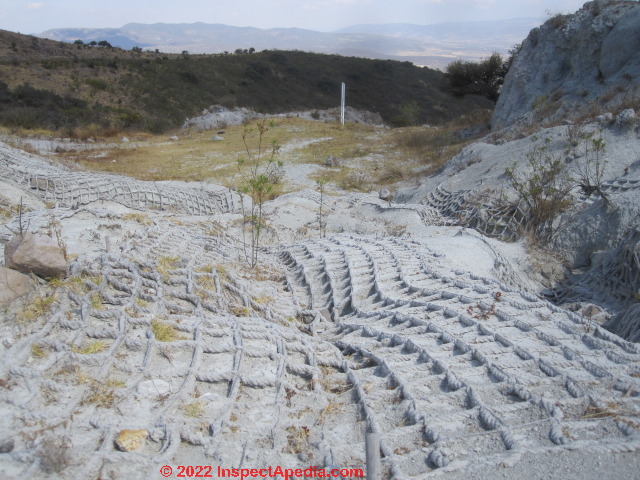 Geotextiles are a strong fabric, usually synthetic but possibly of natural fibers such as jute, used in a wide range of applications to control the movement of soil and water. The fabric is intended to be buried or covered with soil, gravel, or similar materials.
Geotextiles are a strong fabric, usually synthetic but possibly of natural fibers such as jute, used in a wide range of applications to control the movement of soil and water. The fabric is intended to be buried or covered with soil, gravel, or similar materials.
A geotextile fabric permits water to pass through its body while preventing soil to be carried away by the movement of the water.
The geotextile may be used as a flat-spread fabric that covers soil or rock and that is then itself covered with a final layer of soil or sod, or it may be in the form of a tube or sock used, for example, in some erosion control experiments in Australia (Restall 2001) and in some septic system effluent disposal system designs as well as in the treatment of surface water (Moslemizadeh 2009) and sewage sludge (Fowler 1996).
Synthetic geotextiles are typically made of glass, fiberglass, nylon, polyvinyl chloride, polypropylene, or polyester.
Natural fiber matting and geotextiles are typically made of jute, coir (coconut), or other plant or wood fibres.
Photo: rope netting or matting, (not a geotextile) providing a more coarse form of erosion control, in use in Central Mexico in 2011 [DF].
Geotextiles—also known as filter fabrics, synthetic fabrics, construction fabrics or fabrics—are porous fabrics used for erosion and sediment control purposes. Manufacturers create woven geotextiles by weaving fibers together and non-woven geotextiles by bonding fibers together. - US EPA
At buildings and building sites, the most common uses of geotextiles are in building foundation drainage systems, soil erosion control, septic system construction, and beneath gravel, interlocking block, slate or similar walks and driveways. Geotextiles are also being tested in coastal protection systems (ter Harmsel 2018) (Restall 2001), concrete form work (Miller-Johnson 2009), and to improve the performance of timber retaining walls (Levy 1992).
Summary of Geotextile Types for Various Uses
Photo: at this new home in Two Harbors, MN, where clay soils are common, the builder installed sod over a thin layer of well-drained soil-gravel mix that is in turn held in place by a geotextile.
- Backfill over a drainfield trench:
the fabric has to be just strong enough to not tear during backfill over the trench - 2 oz. to 3 oz. thicknesses, using a non-woven geotextile product.
Those lighter weights are strong enough to remain intact during backfill but light enough to have very high permeability - you want good flow rates around a drainfield trench.
See also GEOTEXTILES over SEPTIC SOAKAWAY BEDS - Building perimeter drain
or "French Drain" uses 3-4.5 oz non-woven geotextile.
We may use a waterproof membrane buried and sloped away around a building to prevent water entry when roof edge gutters can't be installed. - Surface erosion control:
use medium-weight non-woven geotextiles in the 4-6 oz range - Weed prevention, soil-gravel separation, under gravel paths,
parking areas, heavy-use areas: use non-woven or woven fabric geotextiles in the 8-16 oz range where traffic might otherwise tear the fabric.
Foundation Drainage Mats & Geotextiles for Foundation Waterproofing

As Carson Dunlop Associates' sketch (above) and our photos (below) illustrate, proper installation of a combination of damp proofing, a drainage mat, and a geotextile to keep the drainage mat from becoming clogged by soil particles can be effective in keeping roof spillage and surface runoff from penetrating the building foundation walls.
Watch out: even this approach won't prevent basement or crawl space water entry if groundwater levels are so saturated that they are rising up beneath the basement floor slab.
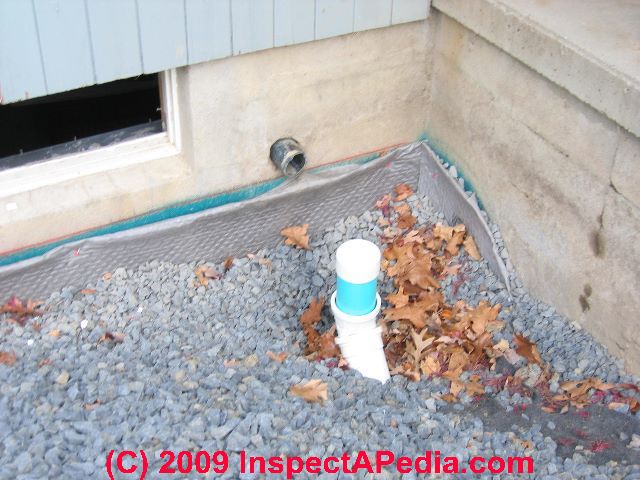
Sealing Foundation Walls: damp-proofing vs waterproofing is explained
and details about water barrier coverings for foundations are found in
our RECOMMENDED ARTICLES list below.
Geotextile Properties, Thickness, Flow-Rate, Durability
Watch out: when choosing a geotextile, be sure to review the manufacturer's product specifications and intended uses.
The geotextile that is most suitable as a pond liner (very durable, with a low gpm flow rate at which water passes through the fabric, is quite different from a geotextile most suitable for filtration or septic system effluent dispersal (higher gpm flow rates).
- Impermeability, typically a property of woven geotextiles, is a desired geotextile feature when the fabric is used for silt fences or pond liners.
- Permeability, typically a property of non-woven geotextiles, is a desired feature where a high water flow-rate through the material is desirable, such as at storm drain inlets, septic effluent dispersal, and in temporary applications such as protecting new soils, seeded ground or topsoil from erosion.
[Reader note: the table below is in process; contributions are invited - Ed.]
Geotextile Properties |
||||||
| Product | Type Woven Non- woven |
Thickness | Opening Size mm US Sieve |
Flow Rate L / M / M2 GPM / ft2 |
Tensile Strength kN lb |
Puncture |
| Agtec | N | 3.1 oz | - #50 |
- 150 |
-. 80 |
- 175 |
| Eastgate EGLS3 | N | > 3.0 oz | - #70 |
- 88 |
- 62 |
- 179 |
| Nilex 4535 3 | N | - | 0.30 #50 |
6112 150 |
356 80 |
934 210 |
| Nilex 4516 3 | N | - | 0.15 #100 |
2037 50 |
1690 380 |
4804 1080 |
| SKAPS GE180 | N | 100 mil 2.5 mm |
0.18 #80 |
4074 100 |
1 225 |
2.67 600 |
| SKAPS GE140 | N | 70 mil 1.77 mm |
0.212 #70 |
6518 160 |
0.467 105 |
1.36 306 |
| SKAPS M220 | W | 0.6 #30 |
1630 40 |
1.31 x 1.16 295 x 260 |
5.7 1300 |
|
| SRW LS3 | N | 3.0 oz | - #70 |
- 88 |
- |
- |
| US Fabrics US 80NW | N | 3.1 oz /y2 105.09 g/M2 |
0.297 #50 |
6112 150 |
356 80 |
770 175 |
| US Fabrics US 7200 | W | - | 0.585 #30 |
611 15 |
124 x 87.5 8500 x 6000 |
- |
Notes to the table above
- In general, non-woven geotextiles are more porous than woven fabrics, and may break down faster (though we have found buried non-woven geotextiles lasting fifteen years or more with no apparent damage - Ed.)
- Nilex, cited below, offers this list of geotextile features that may be compared across products:
Geotextile Mechanical properties: grab tensile strength, grab elongation, CBR puncture, trapezoidal tear
Geotextile Hydraulic properties: apparent opening size, permittivity, water flow rate (l/m/2 or gpm/ft2)
Note: Permittivity is the flow rate (in cubic metres per second), divided by the area of the geotextile tested, divided by the hydraulic head.
Geotextile Endurance - UV resistance (if not buried)
Geotextile Packaging - roll size - Nilex describes at least 11 different geotextile products; we selected two as representative of the range of geotextile features
See NILEX NONWOVEN CIVIL GEOTEXTILE COMPARISON CHART [PDF] , cited in more detail below. - Geotextile Limitations (BMP-17 cited below)
Effectiveness may be reduced drastically if the fabric is not properly selected, designed, or installed.
Many synthetic geotextiles are sensitive to light and should be protected prior to installation.
Geotextiles that are not biodegradable should not be used where their presence or appearance is aesthetically unacceptable.
Geotextiles should not be placed on 50% slopes if they are to be covered with overlying material.
Geotextiles vs Matting - what's the difference
Geotextile
Geotextiles are porous fabrics known in the construction industry as filter fabrics, road rugs, synthetic fabrics, construction fabrics, or simply fabrics.
Geotextiles are manufactured by weaving or bonding fibers made from synthetic materials such as polypropylene, polyester, polyethylene, nylon, polyvinyl chloride, glass, and various mixtures of these materials. - source: Idaho Best Management Practice BMP 17 GEOTEXTILES [PDF] (2005) cited in detail below.
Matting
Matting is a porous net or fibrous sheet that is laid over the ground surface for slope stabilization and erosion control or to hold mulch in place and protect it against wind or water damage.
Matting and netting are sometimes classified as geotextiles (see BMP 17-Geotextile), but in this catalog, matting is considered to be materials made from biodegradable materials including straw, coconut (coir), jute, wood fiber (excelsior), paper, and cotton.
Some of these organic
materials may be held in place by plastic netting. - source: Idaho Best Management Practice BMP 18 MATTING [PDF] (2005) cited in detail below.
Geotextile Research, Studies, Suppliers, Standards
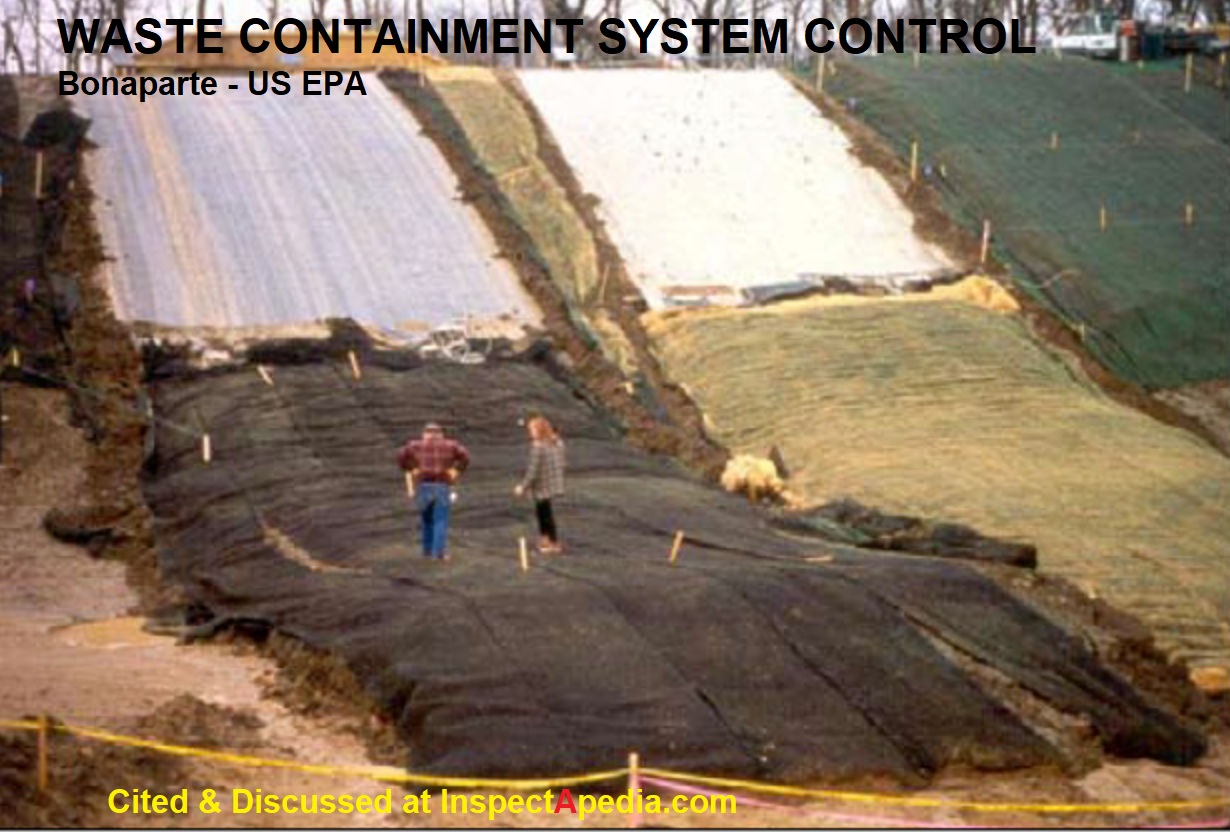 Illustration: using geotextiles as part of waste containment system management - from Bonaparte et als, cited below.
Illustration: using geotextiles as part of waste containment system management - from Bonaparte et als, cited below.
- Ando, Y., E. Noda, and K. Yaginuma. REPORT ON EXCAVATION SURVEYS ON INTERLOCKING BLOCK PAVEMENTS WITH GEOTEXTILE [PDF] (2001) In Proc., The 24th Japan Road Conference, vol. 100, pp. 162-163. 2001
Excerpts:
In Japan, geotextile has been used a part of interlocking block pavement because of expecting to increase its durability.
The application of geotextile for interlocking block pavement between base course and cushion sand under interlocking block prevents the cushion sand loss into the base course.
The loss often causes the change of interlocking block position, damage of interlocking block, and roughness. In addition, mechanical reinforcement and water drainage are secondary functions of geotextile.
Excavation surveys of interlocking block pavement that had been in use for 2-15 years after completion were carried out at five sites in order to quantitatively confirm the effects of geotextile.
Research items were rutting depth, roughness, interlocking block breakage rate, residual rate of joint sand, mixing of cushion sand into base course, the quality of joint and cushion sand, and the properties of geotextile etc. - ASTM D4355 - Standard Test Method For Deterioration Of Geotextiles By Exposure To Light, Moisture And Heat In A Xenon Arc-Type Apparatus
This test method covers the determination of the deterioration in tensile strength of geotextiles by exposure to xenon arc radiation, moisture, and heat. - ASTM D4491 - Standard Test Methods For Water Permeability Of Geotextiles By Permittivity
These test methods cover procedures for determining the hydraulic conductivity (water permeability) of geotextiles in terms of permittivity under standard testing conditions, in the uncompressed state.
Included are three procedures: the constant head and falling head methods using a water flow apparatus, and the air flow method using an air flow apparatus. - ASTM D4533 - Standard Test Method For Trapezoid Tearing Strength Of Geotextiles
This test method is an index test used to measure the force required to continue or propagate a tear in woven or non-woven geotextiles by the trapezoid method.
While useful for quality control and acceptance testing, the trapezoid tear test does not provide all the information needed for all design applications and other test methods should be used. - ASTM D4632 - Standard Test Method For Grab Breaking Load And Elongation Of Geotextiles
This test method is an index test which provides a procedure for determining the breaking load (grab strength) and elongation (grab elongation) of geotextiles using the grab method. This test method is not suitable for knitted fabrics and alternate test methods should be used.
While useful for quality control and acceptance testing for a specific fabric structure, the results can only be used comparatively between fabrics with very similar structures, because each different fabric structure performs in a unique and characteristic manner in this test.
The grab test methods does not provide all the information needed for all design applications and other test methods should be used. - ASTM D4751 - Standard Test Methods For Determining Apparent Opening Size Of A Geotextile
These test methods cover the determination of the apparent opening size (AOS) of a geotextile either by dry-sieving glass beads through a geotextile (Methods A1 and A2) or by using a capillary porometer (Method B). - ASTM D6241 - Standard Test Method For Static Puncture Index Strength Of Geotextiles And Geotextile-Related Products Using A 50 Mm Probe
This test method is an index test used to measure the force required to puncture a geotextile and geotextile-related products with a 50 mm diameter probe rod. The dimensions of the probe provide a multidirectional force on the geotextile. - Bonaparte, Rudolph, D. Daniel, and R. M. Koerner, ASSESSMENT AND RECOMMENDATIONS FOR IMPROVING THE PERFORMANCE OF WASTE CONTAINMENT SYSTEMS [PDF] (2002) Washington, DC, USA: EPA-Environmental Protection Agency, 2002.
- Brady, John T., BENEFICIAL USE OF DREDGED MATERIAL FROM THE DELAWARE RIVER
MAIN CHANNEL DEEPENING PROJECT TO CREATE, RESTORE, AND PROTECT
WETLANDS IN THE DELAWARE BAY, [PDF] (1995) in Restoration, Protection, And Creation: General Wetland Creation And Restoration, National Interagency Workshop On Wetlands: Technology Advances For Wetlands Science, p. 225.
Note: several papers in this document describe the use of geotextiles in various environmental protection projects. - Ed. - Cassidy, Patrick E., Matthew W. Adams and David F. White, EVALUATION of the CHEMICAL RESISTANCE oF GEOTEXTILES, GEONETS, and PIPE [PDF] U.S. EPA,
- CPP’S No-Rock ™ Fabric Wrapped Septic Pipe [PDF] (2019) Crumpler Plastic Pipe, .O. Box 2068, Highway 24 West, Roseboro, NC 28382 USA, Tel: 1-800-334-5071
Email: cppsales@cpp-pipe.com retrieved 2019/02/11 original source: www.cpp-pipe.com/no_rock.htm - Daniel, David E., Paula M. Estornell, Walter E. Grube, and Waste Minimization.COMPILATION OF INFORMATION ON ALTERNATIVE BARRIERS FOR LINER AND COVER SYSTEMS [PDF] Risk Reduction Engineering Laboratory, Office of Research and Development, US Environmental Protection Agency, 1990.
- Filshill, A. "Geotextiles in commercial development." In Geotextiles, pp. 495-509. Woodhead Publishing, 2016.
- Fowler, Jack, ROSE MARY Bagby, and Ed Trainer. "Dewatering sewage sludge with geotextile tubes." In Proceedings of the 49th Canadian Geotechnical Conference, pp. 129-137. Canadian Geotechnical Society, St. John’s, NL, Canada, 1996.
- Ghosh, Amalendu, Ambarish Ghosh, and Ashis Kumar Bera. "Bearing capacity of square footing on pond ash reinforced with jute-geotextile." Geotextiles and Geomembranes 23, no. 2 (2005): 144-173.
- Gupta, A. K. "Geotextiles: opportunities for natural-fibre products." In International Trade Forum, vol. 27, no. 1, p. 10. International Trade Centre, 1991.
- Hamilton, G. W., and D. V. Waddington. "Infiltration rates on residential lawns in central Pennsylvania." Journal of soil and water conservation 54, no. 3 (1999): 564-568.
Abstract:
Home lawns account for a large portion of the pervious segments of urbanized watersheds. Soil movement and compaction during building construction processes alter soil physical properties, and thus, change hydrologic characteristics of the area.
This research quantified the infiltration rates of 15 home lawns in central Pennsylvania and correlated the infiltration rates with selected turf and soil characteristics. Average infiltration rates ranged from 0.4 to 10.0 cm/hr (0.16 to 3.94 in/hr).
Correlations with grass tiller density, soil bulk density, and percentages of sand, silt, and clay were not significant. Excavation procedures and lawn establishment methods appear to affect infiltration of home lawns more than any other factors. - Horz, R. C. GEOTEXTILES FOR DRAINAGE, GAS VENTING AND EROSION CONTROL AT HAZARDOUS WASTE SITES [PDF] Final report 1981-1985. No. PB-87-129557/XAB. Army Engineer Waterways Experiment Station, Vicksburg, MS (USA). Geotechnical Lab., 1986.
- Idaho Department of Environmental Quality. (2005).
BMP 17: GEOTEXTILES In CATALOG OF STORMWATER BEST MANAGEMENT PRACTICES FOR IDAHO CITIES AND COUNTIES (Vol. 2). (2005) Water Quality Division, Idaho Department of
Environmental Quality. Valley County, Idaho
219 N. Main Street
PO Box 1350
Cascade, ID 83611 USA, Website: http://www.co.valley.id.us
Excerpts from above:
Idaho Best Management Practice BMP 17 GEOTEXTILES [PDF] (2005)
Idaho Best Management Practice BMP 18 MATTING [PDF] (2005) - Koerner, Robert M., and George R. Koerner. "Lessons learned from geotextile filter failures under challenging field conditions." Geotextiles and Geomembranes 43, no. 3 (2015): 272-281.
- Koerner, Robert M., and George R. Koerner. LEACHATE CLOGGING ASSESSMENT OF GEOTEXTILE AND SOIL LANDFILL FILTERS [PDF] National Risk Management Research Laboratory, Office of Research and Development, US Environmental Protection Agency, 1995.
- Levy, Sidney M. "Dealing with Difficult Site and Foundation Problems." In The Construction Superintendent’s Handbook, pp. 121-137. Springer, Boston, MA, 1992.
- Maryland Department of the Environment. 2011 MARYLAND STANDARDS AND SPECIFICATIONS FOR SOIL EROSION AND SEDIMENT CONTROL).
[PDF] Website: https://mde.state.md.us/programs/water/StormwaterManagementProgram/Documents/2011 MD Standard and Specifications for Soil Erosion and Sediment Control.pdf
This book discusses soil erosion and sediment control broken into the following sections:
Planning & Design
Grading & Stabilization - minimize potential for erosion during construction
Water Conveyance - convey water around the active construction area (clear-water diversions) or to a sediment control practice.
Erosion Control - reduce erosion from concentrated flow. Erosion control practices can be used for inflow or outlet protection, velocity checks in swales, or to convey water down a slope in non-erosive manner. The design of these practices is based on drainage area, flow rate, location, slope, and velocity.
Filtering - filter and trap sediment for relatively small drainage areas.
Dewatering - remove the water from areas such as foundations for buildings and bridges, utilities, and sediment traps and basins while filtering sediment.
Sediment Trapping - detain and settle sediment-laden runoff from larger drainage areas and include sediment traps and sediment basins.
Miscellaneous - specifications for materials, subsurface drains, channels, temporary access waterway crossings, dust control, and onsite concrete washout structures. - Miller-Johnson, Russ. "Fabric Formwork—An Alternative Concrete Construction System." In Structures Congress 2009: Don't Mess with Structural Engineers: Expanding Our Role, pp. 1-5. 2009.
- Moslemizadeh, Ehsan. "The use of geotextiles for the treatment of surface water." PhD diss., Concordia University, 2009.
- Patel, I. Pravin, and II Rajesh Dhore. USE OF GEOSYNTHETICS IN WATER HARVESTING [PDF] Proc. of The Third Intl. Conf. on Advances in Civil, Structural and Environmental Engineering - ACSEE 2015
ISBN: 978-1-63248-065-1 doi: 10.15224/ 978-1-63248-065-1-89
Abstract Excerpt:
The excess rainwater in monsoon is drained-off by the storm water drain with negligible water recharge . The various water harvesting methods incorporating geosynthetics have been proposed to save the water. The geogrid, geotextile can be incorporated in the geotechnical applications to improve the ground water table. These materials are water preamble and easy to apply in the conventional drainage system.
Water recharge test rig has been constructed using RCC pipes at various locations having different soil type. The water recharge rate has been measured at regular interval. It is mainly applicable in residential area of urban regions and certain industrial area.
‘Water recharge pit’ also have been constructed using sand, locally available aggregate materials and nonwoven fabric. The location of pit should such that accumulated rainwater available to maximize water recharge.
The amount of water recharged has been measured through the pit. The study shows that the needled nonwoven fabric in combination of geogrid filters the rain water and accelerates water recharge rate. The water harvesting using geosynthetics is cost effective way for the ground water recharge. It also help in resolving the water logging in heavy rains. - Propex, SUBSURFACE DRAINAGE [PDF] (2005) Propex Fabrics
Civil Engineering Fabrics
260 The Bluffs
Austell, Georgia 30168
PH:800/445-7732(SPEC)
Fax:770/944-4584
email: geotextiles
web: geotextiles homepage
Excerpt:
Geotextiles have replaced graded soil filters for drainage of virtually all structures, including underdrains, dewatering trenches, intercept drains, pavement edge drains, walls and dams drains, leachate collection/detection removal drains, sport field drain, etc.
Illustration: Stockton Beach Club illustrating use of geotextile sand tubes, in Restall (2001) cited just below.
- Restall, S., L. A. Jackson, Georg Heerten, and Luebbecke Germany. THE CHALLENGE OF GEOTEXTILE SAND CONTAINERS AS
ARMOUR UNITS FOR COASTAL PROTECTION WORKS IN
AUSTRALASIA [PDF] (2001) in Proceedings of the Australasian Coasts and Ports Conference. 2001.
Abstract excerpt:
Sand filled geosynthetic elements are playing an increasing role in the construction of coastal and marine structures.
Traditional construction techniques utilising rock, concrete and steel are being increasingly challenged by alternatives offered in geosynthetic forms for revetments, scour protection, groynes, berms, artificial reefs, reclamation and dunal stabilisation to name but a few. - Restall, S. Jackson, L. A. Jackson, Georg Heerten, and W. P. Hornsey. "Case studies showing the growth and development of geotextile sand containers: an Australian perspective." Geotextiles and Geomembranes 20, no. 5 (2002): 321-342.
Abstract excerpts:
... This paper outlines the historical development of the types of materials used for geotextile containers and the diversity of applications in which these containers are being used.
The type of geotextile used for the containers varies depending on installation conditions. This information has been compiled from years of experience. The range of application for these products is extensive and covers areas such as scour protection, groynes, berms, artificial reefs and containment of hazardous materials.
The development of this form of coastal protection has developed to such a stage that in many cases it is no longer regarded as an alternative construction method but rather the desired solution.
This is not to say that there is not a great deal still to be learnt from this type of protection Initially the main emphasis was on hydraulically filled geotextile tubes (typically 1.2 m2) used mainly as groynes to protect beaches.
With time this focus has changed to individual containers used in coastline protection and marine structures (reefs). - ter Harmsel, Mink. "Dune and residential buildings protection using geotextile tubes, Atlantic Ocean Portugal." In Coasts, Marine Structures and Breakwaters 2017: Realising the Potential, pp. 553-556. ICE Publishing, 2018.
Abstract excerpts:
The coastline of Portugal along the Atlantic Ocean is subject to serious erosion problems of the beaches and dunes. Extreme conditions with more than 7 meter high waves cause a lot of damage to the dunes and are seriously threatening the residential buildings that are situated just behind the dunes areas. ...
the adopted solution (cylinders, apron, sand nourishment, construction details, beach behaviour, structure behaviour) and the lessons learned on this project during preparation phase, installation phase of geotextile tubes and the phase after the realization until now. - US EPA BEST MANAGEMENT PRACTICES (BMPs) for SOILS TREATMENT [PDF] Suggested Operational Guidelines to Prevent CrossMedia Transfer of Contaminants During Cleanup Activities
- US EPA, GEOTEXTILES, MATTING and NETTING [PDF] U.S. EPA, Office of Water Management, retrieved 2022/07/28, original source: https://www.epa.gov/system/files/documents/2021-11/bmp-geotextiles-matting-and-netting.pdf
Excerpts:
Geotextiles—also known as filter fabrics, synthetic fabrics, construction fabrics or fabrics—are porous fabrics used for erosion and sediment control purposes. Manufacturers create woven geotextiles by weaving fibers together and non-woven geotextiles by bonding fibers together.
Non-woven geotextiles are more porous than woven geotextiles and typically break down faster.
Geotextiles consist of synthetic materials such as polypropylene, polyester, polyethylene, nylon, polyvinyl chloride, glass and various mixtures of these materials. Matting typically consists of jute, coir or other wood fibers that manufacturers have formed into sheets.
Matting serves similar purposes as traditional loose mulch but is more stable. Netting typically consists of jute, wood fiber, plastic, paper or cotton and can hold mulching and matting to the ground. Netting alone can also stabilize soils and help establish vegetation. - US EPA, National Menu of Best Management Practices (BMPs) for Stormwater, Website: https://www.epa.gov/npdes/national-menu-best-management-practices-bmps-stormwater#edu
- US EPA, SEDIMENT and EROSION CONTROL [PDF] (1992) USDA Soil Conservation Service,
- USFS SOIL STABILIZERS on UNIVERSALLY ACCESSIBLE TRAILS [PDF] US Forest Service]
- Washington State Department of Transportation. (2019). STANDARD SPECIFICATIONS FOR ROAD, BRIDGE, AND MUNICIPAL CONSTRUCTION 2022 (M 41-10). [PDF] Website: https://www.wsdot.wa.gov/publications/manuals/fulltext/M41-10/SS.pdf
- Yee, T. W., L. Ding, L. K. Lim, and Z. Y. Wang. "Geotextile containment and dewatering of contaminated sediments in China." In Proceedings of 2011 WEDA Technical Conference and Texas A&M Dredging Seminar. 2011.
- Welesameil, Mengstab Tilahun. OPTIMIZATION OF ON-SITE TREATMENT SYSTEMS: FILTRATION USING GEO-TEXTILE FILTERS FOR SOURCE SEPARATED BLACK WASTEWATER [PDF] Master's thesis, Norwegian University of Life Sciences, 2012.
- WI, GUIDANCE FOR THE USE OF GEOSYNTHETIC CLAY LINERS (GCLs) AT SOLID WASTE FACILITIES [PDF] (2000) Wisconsin Department of of Natural Resources
Geotextile Fabric Sources & Specifications
Illustration: a woven geotextile or geosynthetic fabric from Brockwhite, cited below.
- Agtec, 125 Mayo Rd., Hampden ME 04444, Tel: 1-207-692-0700, email: sales@agtec.com Website: agtec.com/agtec-non-woven-3-1oz-geotextile-fabric-choose-size
Website excerpts:
These non-woven polypropylene geotextiles are made from staple fibers used for soil separation and drainage used primarily for subsurface drainage and filtration applications such as French drains, trench drains and blanket drains.
These geotextiles help prevent dirt and aggregate from clogging your drains, extending drainage system lifespans and increasing performance.
With excellent soil retention and hydraulic properties this fabric has the versatility to be used in a wide variety of applications including subsurface drainage and roadway separation applications.
Applications include underneath highways, walkways, patios, landscape water features, under riprap to divert excess water, erosion control, retaining walls and for heavy duty drainage applications. Select thickness depending on your application.
Geotextile Weight by General Usage
3.1 oz - is a light weight non-woven fabric with high tensile strength. 3.1 oz is an excellent general filter fabric. Great for under patios, walkways, driveways.
4.5oz - Is a medium weight non-woven fabric with excellent physical properties in addition to high tensile strengths. Makes an excellent general drainage fabric. Can be used under driveways, roads, building projects.
6oz - Is a high weight non-woven fabric. Also used for soil reinforcement, separation, filtration and erosion control. Used under major road and building projects.
8oz - Is a heavy-duty non-woven fabric. Used for the very heaviest of applications such as major highways or very large building projects. - Building & landscape suppliers such as Lowes, Home Depot, Menards and your local hardware store
- Brockwhite Construction Materials, Geosynthetics Supplier for Canada & the U.S., Web: https://www.brockwhite.com/ - illustrated above, offices in Wisconsin, North Dakota, Minnesota, South Dakota, Montana; Tel: 1-800-880-3210.
- Eastgate Supply, Geotextiles, EASTGATE EGLS3 GEOTEXTILE FABRIC SPECIFICATIONS [PDF] EastGate Supply, PO Box 84, Bothell WA 98041, USA, Tel: 800-583-4891, Email: support@eastgatesupply.com Web: eastgatesupply.com , retrieved 2022/07/28, original source: cdn.shopify.com/s/files/1/0043/5716/0995/files/EGLS3.pdf?v=1610413181
- Nilex NILEX NONWOVEN CIVIL GEOTEXTILE COMPARISON CHART [PDF] , Nilex Civil Environmental Group, #2, 40 Audia Court Vaughan, ON L4K 3N4 Canada Web: https://nilex.com/nonwoven-geotextiles/ Tel: 800.667.4811 Email:
info@nilex.com Locations in the U.S. & Canada
- Pro Fabric Supply, Geotextile Supplier, 7 REASONS WHY PROFESSIONALS ALWAYS USE LANDSCAPE FABRIC UNDER GRAVEL [PDF] (2020) Pro Fabric, PO Box 562, Bothell, WA 98041 USA, Web: https://www.profabricsupply.com/ Tel: (800) 520-7731, retrieved 2022/07/28 original source: https://www.profabricsupply.com/blogs/articles/7-reasons-why-professionals-always-use-landscape-fabric-under-gravel
Pro Fabric Supply, 7 COMMON FRENCH DRAIN MISTAKES & HOW TO AVOID THEM [PDF] Pro Fabric Op Cit., retrieved 2022/07/28 original source: https://www.profabricsupply.com/blogs/articles/7-common-french-drain-mistakes-how-to-avoid-them - SRW SRW LS3 GEOTEXTILE SPECIFICATIONS [PDF] , SRW Products, PO Box 70, 32005 126th St., Princeton MN 55371 USA, Tel: 800-752-9326, Web: SRWProducts.com Geotextiles, retrieved 2022/07/28, original source: landscapediscount.net/images/spec/LS3-Spec-Sheet-2020.pdf
- Skaps Industries, 335 Athena Dr., Athens GA 30601 USA, Email: contact@skaps.com, Website: skaps.com, Tel: +1 (706) 354-3700
Note: Skaps offers at least 36 different non-woven geotextiles for a variety of purposes, and the company offers 13 different woven geotextile products and slit tapes.
SKAPS ENVIRONMENTAL GRADE GEOTEXTILE CHART [PDF] GE140, GE160, GE180, GE 110, GE112, GE114, GE116
SKAPS HIGH STRENGTH WOVEN MONOFILAMENT GEOTEXTILE CHART [PDF] M404, M706, M220, M330, M440
SKAPS HEAVYWEIGHT NONWOVEN GEOTEXTILES CHART [PDF] GE200, GE240, GE280, GE320
Illustration: Geosynthetics of a range of types, from US Fabrics Geosynthetics Line Card cited in detail below.
- US Fabrics, Geotextile Supplier, 2904 Virginia Ave., Cincinnati OH 45227 USA, Email: info@usfabrics.com Web: https://www.usfabricsinc.com/products/geotextiles/, Tel: (800) 518-2290 [Address: hidden at website]
The company offers dozens of various geotextile fabrics for a wide range of uses, including Woven Filtration Geotextiles, Woven High Tensile Modulus Geotextiles, Woven Reinforcement Geotextiles, Woven Stabilization and Separation Geotextiles
Website excerpts:
Nonwoven Applications Asphalt Overlay, Cow Carpet, Drainage, French Drains, Filter Fabric, Geomembrane Cushion, Landscape Fabric, Pipe Wrap, Railroad Ballast Separation, Rip-Rap, Separation Under Pavers, Subsurface Drainage, Trench Drains, Underdrains, Weed Barrier
US Fabrics NONWOVEN GEOTEXTILE 80NW PRODUCT SPECIFICATIONS [PDF] - retrieved 2022/07/28 original source: https://www.usfabricsinc.com/assets/pdf/products/us-80nw/us-80nw.pdf
US Fabrics WOVEN GEOTEXTILE 7200 PRODUCT SPECIFICATIONS [PDF] - retrieved 2022/07/28 original source: https://www.usfabricsinc.com/assets/pdf/products/us-7200/us-7200.pdf
US Fabrics GEOSYNTHETICS LINE CARD [PDF]
Website excerpt:
A woven geotextile is a planar textile structure produced by interlacing two or more sets of strands at right angles. There are two types of strands: slit films, which are flat; and monofilaments, which are round.
Woven slit-film geotextiles are generally preferred for applications where high strength properties are needed and filtration requirements are less critical.
These fabrics reduce localized shear failure in weak subsoil conditions and aid construction over soft subsoils.
Woven monofilament geotextiles are preferred for applications where both strength and filtration are a concern, such as shoreline rip rap applications.
...
Reader Comments, Questions & Answers About The Article Above
Below you will find questions and answers previously posted on this page at its page bottom reader comment box.
Reader Q&A - also see RECOMMENDED ARTICLES & FAQs
What is the Recommended Geotextile for Use over Septic Drainfields?
I plan on using a Geotextile fabric filter over my leach lines. However, what is the recommended type of Geotextile weight/thickness for septic fields? I've seen everything from 0.5 oz - 8oz being sold. Is it better to use thinner fabric for septic fields so gases and water can move more freely? Any suggestions is greatly appreciated!
thank you so much! On 2022-07-28 by Zachary
This Q&A were posted originally
at SEPTIC DRAINFIELD SIZE
Reply by InspectApedia-911 (mod) - use 2-3 oz non-woven geotextile over a drainfield trench.
@Zachary,
Thank you for a helpful question.
Bottom line: use a 2-3 oz non-woven geotextile over a drainfield trench.
Details:
Because all geotextiles are designed to be water permeable, the main factor in choosing which to use is the requirement for durability.
In the case of backfill over a drainfield trench, the fabric has to be just strong enough to not tear during backfill over the trench - probably 2 oz. to 3 oz. thicknesses range, using a non-woven geotextile product. Those lighter weights are strong enough to remain intact during backfill but light enough to have very high permeability - you want good flow rates around a drainfield trench.
Over a building perimeter drain or "French Drain", builders use 3-4.5 oz non-woven geotextile.
Medium-weight non-woven geotextiles in the 4-6 oz range are used to control surface erosion or perhaps under gravel paths.
Heavier non-woven as well as woven fabric geotextiles in the 8-16 oz range are more likely to be selected for use under gravel paths or parking areas where traffic might otherwise tear the fabric.
See also:
NO-ROCK SEPTIC GEOTEXTILE-WRAPPED PIPE
Additional Source: "What's the Best Landscape Fabric for Draining Water?" Eastgate landscape supply, PO Box 84, Bothell, WA 98041 USA, (800) 583-4891 Email: support@eastgatesupply.com, Web: eastgatesupply.com/Followup by Zachary
@InspectApedia-911, Thank you so much for your quick reply! We have a local company here in Western NY that sells septic tanks and supplies and they have a geotextile fabric for leach fields but it is only 0.6 oz and I thought that was pretty thin. Maybe I'll just carefully layer it. Let me know your thoughts!
thanks again!Reply by InspectApedia-911 (mod)
@Anonymous,
Thanks to your question I've spent the whole day on this topic - see our updated article above.
Bottom line: a very thin geotextile is more-likely to be torn or damaged, that's why a drainfield trench would usually use the heavier weight I cited.
You could try layering it and it may be fine, but honestly we've no expert source nor experience that discusses that approach.There is a very significant variation in geotextile gpm flow rates
@InspectApedia-911, I just looked over your new write up! Looks great - This site has been so helpful!
One thing I will note is that during my search today I've found some manufacturers with a 3 oz geotextile that actually have fairly low gpm rates.For example, Eastgate Supply has a 3 oz (EGLS3) that has a rating of only 88 gpm.
I thought this was an error and emailed their support to confirm and he said it was correct. Apparently their 3oz is produce slightly different causing lower gmp rates.
However, I've seen companies with a 3.1 oz fabric and the gmp rate jumps back to 150.
Do you think I should go with the 3.1 oz due to the higher gpm rate?
Thanks Thanks again for all the advice! - On 2022-07-29 by ZacharyReply by InspectApedia-911 (mod) - use higher gpm-rate geotextiles for septic drainfield construction
@Zachary,
That's so interesting.A low-flow rate geotextile is perhaps one designed for use as a pond liner while high gpm flow rate geotextiles are more suitable for uses where we want water to flow freely through the material, such as in septic effluent dispersal systems.
Any details you can offer, brands, products, flow rate data would be very helpful.
It makes sense that various geotextile fabrics may be designed for a particular application, but a buyer may not know that.
I've added a geotextile data properties table to include flow rates above in this article.Followup by Zachary - geotextile flow rate variations
@InspectApedia-911, Sure - I'll provide a few links below..
EastGate Supply 3oz:
https://cdn.shopify.com/s/files/1/0043/5716/0995/files/EGLS3.pdf?v=1610413181
SRW 3oz:
http://www.landscapediscount.net/images/spec/LS3-Spec-Sheet-2020.pdf
Take a look at these specs and let me know your thoughts...Assuming they are accurate, I should go with something with higher water flow rate, correct?
Here is the AgTec 3.1 that I was looking at:
https://www.agtec.com/agtec-non-woven-3-1oz-geotextile-fabric-choose-size
Thank you!
...
Continue reading at WATER ENTRY/DAMAGE PREVENTION WITHOUT GUTTERS, or select a topic from the closely-related articles below, or see the complete ARTICLE INDEX.
Or see these
Recommended Articles
- BASEMENT WATERPROOFING
- EXTERIOR WATER SOURCE ELIMINATION
- FOUNDATION WATERPROOFING
- GEOTEXTILES over SEPTIC SOAKAWAY BEDS
- GRADING, DRAINAGE & SITE WORK
- HOUSEWRAP PRODUCT CHOICES
- LAGOON SEPTIC MAINTENANCE
- NO-ROCK SEPTIC GEOTEXTILE-WRAPPED PIPE
- PERM RATINGS of BUILDING MATERIALS
- SOIL PROPERTIES & BUILDING FAILURES
- WATER BARRIERS, EXTERIOR BUILDING
- WATER ENTRY/DAMAGE PREVENTION WITHOUT GUTTERS - use buried geotextiles & water barriers + surface grading
- WET BASEMENT PREVENTION
Suggested citation for this web page
GEOTEXTILES & DRAINAGE MATS at InspectApedia.com - online encyclopedia of building & environmental inspection, testing, diagnosis, repair, & problem prevention advice.
Or see this
INDEX to RELATED ARTICLES: ARTICLE INDEX to BUILDING LEAKS & WATER ENTRY
Or use the SEARCH BOX found below to Ask a Question or Search InspectApedia
Ask a Question or Search InspectApedia
Try the search box just below, or if you prefer, post a question or comment in the Comments box below and we will respond promptly.
Search the InspectApedia website
Note: appearance of your Comment below may be delayed: if your comment contains an image, photograph, web link, or text that looks to the software as if it might be a web link, your posting will appear after it has been approved by a moderator. Apologies for the delay.
Only one image can be added per comment but you can post as many comments, and therefore images, as you like.
You will not receive a notification when a response to your question has been posted.
Please bookmark this page to make it easy for you to check back for our response.
IF above you see "Comment Form is loading comments..." then COMMENT BOX - countable.ca / bawkbox.com IS NOT WORKING.
In any case you are welcome to send an email directly to us at InspectApedia.com at editor@inspectApedia.com
We'll reply to you directly. Please help us help you by noting, in your email, the URL of the InspectApedia page where you wanted to comment.
Citations & References
In addition to any citations in the article above, a full list is available on request.
- In addition to citations & references found in this article, see the research citations given at the end of the related articles found at our suggested
CONTINUE READING or RECOMMENDED ARTICLES.
- Carson, Dunlop & Associates Ltd., 120 Carlton Street Suite 407, Toronto ON M5A 4K2. Tel: (416) 964-9415 1-800-268-7070 Email: info@carsondunlop.com. Alan Carson is a past president of ASHI, the American Society of Home Inspectors.
Thanks to Alan Carson and Bob Dunlop, for permission for InspectAPedia to use text excerpts from The HOME REFERENCE BOOK - the Encyclopedia of Homes and to use illustrations from The ILLUSTRATED HOME .
Carson Dunlop Associates provides extensive home inspection education and report writing material. In gratitude we provide links to tsome Carson Dunlop Associates products and services.


